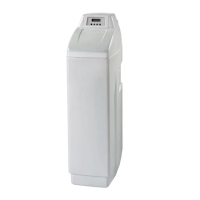EQUIPMENT INSTALLATION
General Warnings And Safety Information
Electrical
There are no user-serviceable parts in the AC adapter, motor,
or controller. In the event of a failure, these should be replaced.
• All electrical connections must be completed according to
local and national codes.
• Use only the power AC adapter that is supplied.
• The power outlet must be grounded.
• To disconnect power, unplug the AC adapter from its
power source.
Mechanical
• Do not use petroleum based lubricants such as petroleum
jelly, oils, or hydrocarbon based lubricants. Use only
100% silicone lubricants.
• All plastic connections should be hand tightened. PTFE
plumber tape may be used on connections that do not
use an O-ring seal. Do not use pliers or pipe wrenches.
• All plumbing must be completed according to local, state
and international codes.
• Soldering near any plastic fi ttings should be done before
connecting fi ttings to the valve. Excessive heat will cause
interior damage to the valve.
• Observe drain line requirements.
• Do not use lead-based solder for sweat solder
connections.
• The drain line must be a minimum of 1/2-inch diameter.
Use 3/4-inch pipe if the backwash fl ow rate is greater than
7 gpm (26.5 Lpm) or the pipe length is greater than
20 feet (6 m).
• Do not support the weight of the system on the control
valve fi ttings, plumbing, or the bypass.
• It is not recommended to use sealants on the threads.
Use plumber tape on all threaded connections.
General
• Observe all warnings that appear in this manual.
• Keep the unit in the upright position. Do not turn on side,
upside down, or drop. Turning the tank upside down will
cause media to enter the valve.
• Operating ambient temperature is between 34°F (1°C)
and 120°F (49°C).
• Operating water temperature is between 35°F (1°F) and
100°F (38°C).
• Working water pressure range is 20 to 125 psi
(1.38 to 8.6 bar). In Canada the acceptable working water
pressure range is 20 to 100 psi (1.38 to 6.89 bar).
• Use only salt salts designed for water softening. Do not
use ice melting, block, or rock salts.
• Follow state and local codes for water testing. Do not
use water that is micro biologically unsafe or of unknown
quality.
• When fi lling media tank, do not open water valve
completely. Fill tank slowly to prevent media from exiting
the tank.
• When installing the bypass water connection, connect
to the plumbing system fi rst. Allow heated parts to cool
and cemented parts to set before installing any plastic
parts. Do not get primer or solvent on O-rings, nuts, or the
valve.
System Recharge Cycles (9-Cycle Operation)
Service (Downfl ow):
Untreated water is directed down through the resin bed and up
through the riser tube. The hardness ions attach themselves
to the resin and are removed from the water. The water is
conditioned as it passes through the resin bed.
1. Brine Refi ll:
Water is directed to the salt tank at a controlled rate, to
create brine for the next recharge.
2. Brine Prep (Dissolve Salt)
After the refi ll cycle fi lls the salt tank with water, this cycle
allows time for the salt to dissolve into the water.
3. Backwash 1 (Upfl ow):
The fl ow of water is reversed by the control valve and
directed down the riser tube and up through the resin bed.
During the backwash cycle, the bed is expanded and debris
is fl ushed to the drain.
4. Brine Draw (Downfl ow):
The brine draw cycle takes place during the slow rinse
cycle. The control directs water through the brine injector
and brine is drawn from the salt tank. Brine draw is
completed when the air check in the salt tank closes.
5. Slow Rinse (Downfl ow):
The brine is directed down through the resin bed and up
through the riser tube to the drain. The hardness ions are
displaced by sodium ions and are sent to the drain. The
resin is recharged during the brine cycle.
6. Repressurize Cycle (Hard Water Bypass Flapper Open):
This cycle closes the fl appers for a short time to allow the
air and water to hydraulically balance in the valve before
continuing the recharge.
7. Fast Rinse 1 (Downfl ow):
The control directs water down through the resin bed and
up through the riser tube to the drain. Any remaining brine
residual is rinsed from the resin bed.
8. Backwash 2 (Upfl ow):
The fl ow of water is reversed by the control valve and
directed down the riser tube and up through the resin bed.
During the backwash cycle, the bed is expanded and debris
is fl ushed to the drain.
9. Fast Rinse 2 (Downfl ow):
The control directs water down through the resin bed and
up through the riser tube to the drain. Any remaining brine
residual is rinsed from the resin bed.
OM26KCS, OM32KCS, OM36KCS, OM40KCS JA13 • 3

